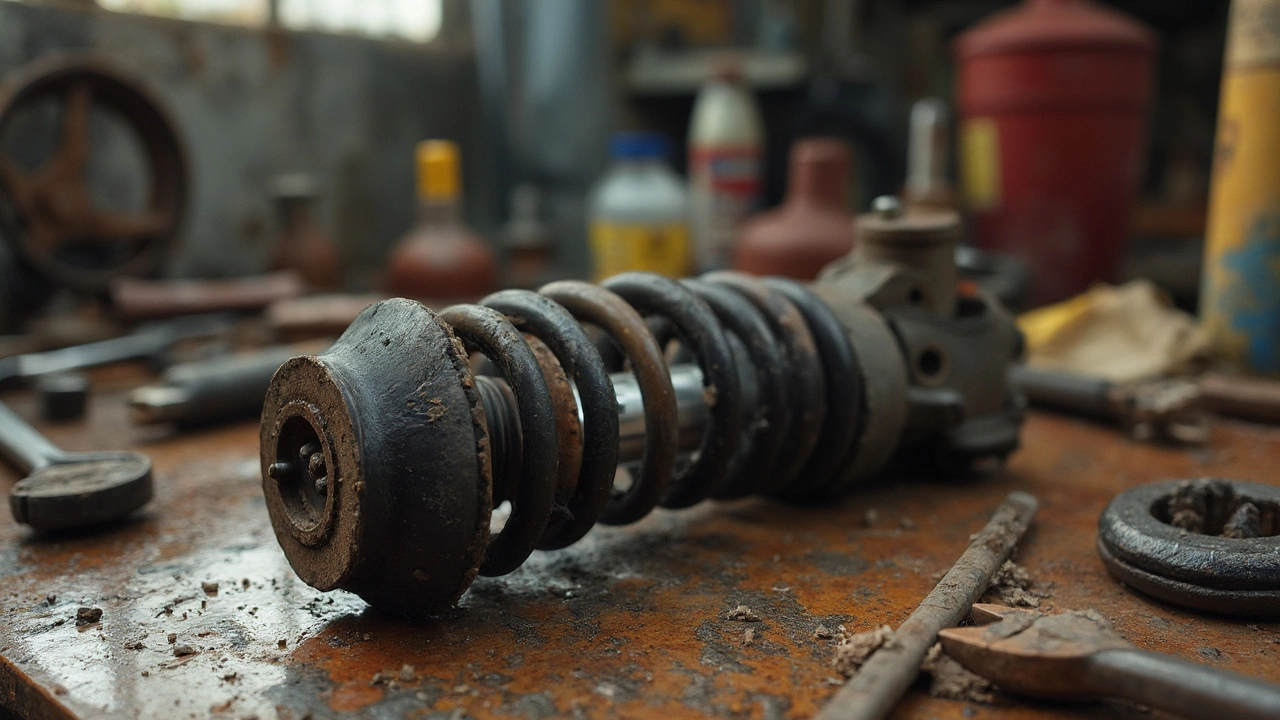 Apr, 8 2025
Apr, 8 2025
So, you've hit a pothole the size of a crater, and now you're worried your car's suspension is bent. Will it crumble on your next drive, or can you risk it? Driving with a bent suspension is more than just a wobblier ride; it could be flirting with disaster.
A bent suspension can mess with how your car handles, making those standard turns feel like you're suddenly a Nascar driver taking on 200 mph. Not to mention, it can cause uneven tire wear, meaning more trips to the tire shop and less gas money. It's not just about comfort; it's about safety and keeping your wallet happy in the long run.
Ignoring a bent suspension is like ignoring a stubbed toe that probably needs an X-ray; it might seem small, but it can morph into a painful problem. Knowing the signs of a bent suspension can save you from a huge headache down the road. So, let's jump into what's going on under your car and figure out the best way forward.
- What is a Suspension and How Does It Work?
- Signs Your Suspension Might Be Bent
- Risks of Driving with a Bent Suspension
- When Should You Consider Repairs?
- DIY Checks and Professional Help
What is a Suspension and How Does It Work?
A car suspension is like the unsung hero of your vehicle. It’s not flashy, but it's crucial for keeping you comfy and safe. At its core, the suspension connects your wheels to the rest of the car, making sure you can smoothly glide over bumps and dips without shaking your teeth out.
Think of the suspension like a team of parts working together to strike a balance between your car’s speed and its stability. It includes springs, shock absorbers, and struts. The springs absorb the energy from bumps and dips. Whether it's a coil spring or a leaf spring depends on your ride's design. Meanwhile, shock absorbers do what their name suggests – they absorb shocks. They stop your car from bouncing around like a trampoline by controlling the movement of springs.
Your vehicle’s suspension doesn't just play a role in comfort. It's key to handling and braking. Without it, turning a corner would feel like steering a roller coaster. It keeps the tires firmly planted on the road, ensuring you have grip and control, especially when you need it the most.
But here's the thing: if any of these parts get out of whack, like with a bent suspension, that smooth ride gets rough. Suddenly, those everyday grooves in the pavement feel like massive craters. And it's not just about comfort – safety takes a hit too.
Remember, keeping your suspension in top shape isn’t just a road luxury—it's essential for both your wallet and well-being.
Signs Your Suspension Might Be Bent
Wondering if your car's acting up after a rough ride over a pothole? Well, it might be your bent suspension talking. Catching these early signs can help you avoid more serious issues down the road.
First off, pay attention to how your car handles. If you notice steering that feels sluggish or doesn't respond like it used to, that's a red flag. A bent suspension can cause your car to drift to one side while driving straight, almost like it has a mind of its own. If you feel like you're wrestling with the wheel just to stay in your lane, you're not imagining things.
Then there are the noises. If your car starts sounding like a rock concert—clunking, knocking, or squeaking whenever you hit a bump—it's time to check that suspension. These sounds often signal trouble underneath. Vehicle handling isn't just about steering; it's about sounds, too. Weird noises usually mean something's not holding up right.
Also, take a look at your tires. They're the unsung heroes dealing with road abuse, but if your suspension is bending, they might wear unevenly. If one tire looks more worn out than the others, that's a clue your car maintenance checklist should include a suspension check. Uneven tire wear can lead to more frequent replacements, and no one wants to burn through tires like they're going out of style.
Last but not least, how's your braking? If your car dips forward excessively when you brake, your suspension might be a part of that dance. A well-functioning suspension keeps your car stable, especially during sudden stops. So, if braking turns into a rollercoaster ride, it's time for a check-up.
Keep an eye on these signs, and you'll save yourself a lot of trouble in the long run. Recognizing these early can mean the difference between a simple repair and a full-blown overhaul. So, listen to your car; it’s trying to tell you something.

Risks of Driving with a Bent Suspension
Driving with a bent suspension isn't just about a bumpier ride. It's about gambling with your safety and your car’s health. When the suspension’s out of whack, even the most mundane drives can become nerve-wracking.
First up, handling goes haywire. Your car might pull to one side, making it feel like it’s got a mind of its own. This isn't just annoying; it’s dangerous, especially in emergency maneuvers or wet conditions. The alignment is off, and steering becomes unpredictable, setting the stage for accidents.
Your tires also take a hit, literally. With uneven pressure and angles, they wear out faster, which means more frequent (and costly!) replacements. Ever notice that swirly air pressure light on your dash? Yeah, it’ll become a regular sight.
And don’t forget the domino effect on other parts. Stress on the suspension can transfer to other components, like axles, which weren't designed to handle the added strain. More often, this damage isn't immediately noticeable, but it leads to expensive repairs down the line.
Lastly, there's the impact on your comfort. Feeling every bump and crack could mean your suspension needs a good look. But more than that, driving like this can cause fatigue faster, and we all know tired drivers aren’t safe drivers.
In short, driving with a bent suspension is like letting your friend who's had one too many take the wheel—not the best idea in terms of safety or cost. So, if you suspect something's up with your suspension, it's time to check it out before it checks out on you!
When Should You Consider Repairs?
Alright, so you suspect your car's suspension has gone wonky. But when exactly should you consider taking your car to a repair shop? Ignoring a bent suspension can lead to more damage, not only on your wallet but potentially your safety, too. Let's break down when it's time to stop procrastinating.
First off, if you're hearing weird noises like clunks, creaks, or rattles when driving over bumpy roads, your car is probably talking to you. That's often a sign something’s off with the suspension system. It's like your car’s way of saying, 'Help me!'
Another big clue is if you've noticed any trouble steering. Maybe the steering wheel feels loose, or the car is pulling to one side. That's your cue to get an expert's opinion. Modern cars are meant to drive straight unless you're actually turning, so anything different needs attention.
Pay attention to uneven tire wear. If one side looks more worn out than the other, that's another hint. Even a slight bend in the suspension can mess with alignment, causing your tires to wear out faster.
Lastly, just trust your gut. If driving doesn't feel right—like the vehicle feels bouncier than a trampoline—it’s better to be safe than sorry. After an inspection, a mechanic can tell you whether a simple alignment could fix the issue or if you need more extensive repairs.
So, what's the bottom line? Whenever you notice these signs, it might be time to bid farewell to that bent suspension. Don't wait for a little problem to ruin your day—or your car!

DIY Checks and Professional Help
So, you've got that nagging feeling something's off with your suspension. Before heading to the pros, there are some DIY tricks you can try out. These simple checks won't fix a bent suspension, but they can give you a good idea of what's going wrong under your hood.
First up, take a look at your tires. Uneven wear patterns often scream bent suspension. If one tire's tread is way more worn than its buddies, that's a red flag. While you're at it, bounce each corner of your car. If it bounces more than twice after you push down, your suspension might be crying for help.
Next, listen up for any funny noises. Unusual clunks or creaks, especially when you're turning or going over bumps, aren't just annoying—they could mean trouble. Check for any obvious leaks under the car too. An oily or rusty puddle could mean your shock absorbers are past their prime.
If these checks have you scratching your head, it's time to call in the experts. Suspension issues like these need a pro's touch to make sure your wheels are safe and sound. A qualified mechanic can jack up your car, inspect it properly, and use tools you probably don't have lying around. They'll look for signs of metal fatigue or broken parts that you can't see with just your eyes.
Think your budget is too tight for the workshop? Consider the long-term costs of ignoring the issue—like greater wear on other parts, decreased vehicle performance, and the possibility of a blowout on the highway. So, it's not just about fixing the bent suspension; it's about peace of mind while driving.
Oh, and here's a little nugget: Routine check-ups can prevent costly surprises. Staying ahead with regular maintenance means fewer troubles and keeps your car's resale value up. Win-win, right?